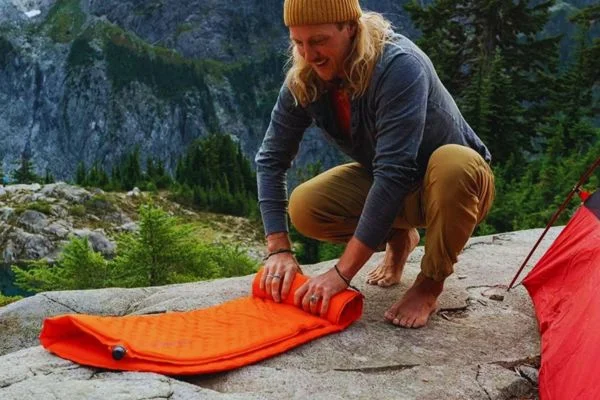Many people ask when to go for traveling how to carry a sleeping bag in a backpack. Carrying a sleeping bag in a backpack is about packing and preparation. To ensure your sleeping bag stays secure and dry, there are some steps you should take when packing it into your backpack.
How To Carry A Sleeping Bag In A Backpack?
Begin by rolling up the sleeping bag tightly and securing it with either straps or bungees to compress its volume and make it easier to fit into the backpack.
“Step-by-step”
Step 1: Choose the Right Sleeping Bag

You should first choose a sleeping bag that is suitable for your adventure. Weight and temperature ratings are important to consider. When backpacking, you need a compact and lightweight sleeping bag.
Step 2: Compress the Sleeping Bag
Make sure your sleeping bag is compressed before you begin packing. Compression sacks or straps can be used to squeeze it down. The bag is also kept clean and dry by this method.
Step 3: Line Your Backpack
Put a waterproof liner or plastic bag in the bottom of your backpack. A moisture and dirt-resistant layer is added.
Step 4: Pack the Sleeping Bag at the Bottom
The compressed sleeping bag should be placed at the bottom of your backpack. Your pack will be more stable and other items will be cushioned by this.
Step 5: Distribute Weight
The heavier items should be placed closer to your back, while the lighter items should be placed outside. You will be able to carry your backpack more easily if you do this.
Step 6: Utilize Extra Compartments
Make use of the pockets and compartments in your backpack. These spaces make it easy to organize small items such as socks and a headlamp.
Step 7: Secure and Adjust
In the end, secure all zippers and straps. Don’t let anything bounce around and make sure it’s snug. For a comfortable fit, adjust the shoulder and hip straps. You’re good to go. If you follow the given above steps I am sure you have no problem about how to carry a sleeping bag in a backpack.
Read more about Is A Small Backpack Considered A Carry On?
How do you pack a sleeping pad in a backpack? 8 Steps
Follow the given steps on packing a sleeping pad in a backpack. These steps are given below:
Step 1: Choose the Right Sleeping Pad
Choosing the right sleeping pad is the first step in planning your outdoor adventure. Size, weight, insulation, and comfort are all important factors to consider when choosing a pad. You should choose a backpack pad that fits your backpack’s dimensions while providing the necessary level of cushioning and warmth.
Step 2: Clear the Backpack
To pack, empty your backpack completely. As a result, you’re able to visualize the available space and ensure that no gear or items obstruct your sleeping pad’s packing.
Step 3: Roll the Sleeping Pad

Starting from one end, roll up the sleeping pad tightly and compactly starting from the bottom. If air is trapped within the pad, gently press down to release it, which results in a tighter roll.
Step 4: Secure with Straps
There are usually straps or clips built into most sleeping pads. Roll the pad tightly and secure it with these straps. Alternatively, you can use separate compression straps if your pad lacks these features. The pad is kept in a neat package by this action, which prevents it from unrolling.
Read more about How To Fix Backpack Strap?
Step 5: Backpack Bottom
Roll your sleeping pad and place it at the bottom of your backpack. As a cushion, it creates a buffer between your back and any rigid items in your pack, enhancing comfort and the weight distribution more balanced, enhancing stability.
Step 6: Vertical or Horizontal
In your backpack, decide if you want to orient the sleeping pad vertically or horizontally. It is effective to place the straps vertically along the length of a larger backpack. Conversely, smaller packs are best positioned horizontally at the bottom, making use of their width.
Step 7: Center or Side
Choose whether to position the sleeping pad against the backside of the backpack or in the center. This helps to maintain balance by evenly distributing the load along the pack’s axis. It is easier and quicker to set up the pad at rest stops when the pad is placed against the back.
Step 8: Pack Around the Pad
Arrange your other gear systematically around the sleeping pad. Make sure your hiking shoes fit snugly to prevent shifting. Keep heavier items close to your back to distribute weight and maintain stability. Prepare your gear strategically so you can pack efficiently and retrieve it easily during your outdoor adventure.
Read more about Can I Carry On A Small Suitcase And A Backpack?
Final words on how to carry a sleeping bag in a backpack
Properly packing and preparing your sleeping bag for a backpack is essential for staying comfortable and secure while on the trail. Following the steps outlined here will help you ensure your sleeping bag stays safe, dry, and in its place no matter where your adventures take you.
FAQs about how to carry a sleeping bag in a backpack
What is the best way to pack a sleeping bag in a backpack?
Begin by rolling up the sleeping bag tightly and securing it with either straps or bungees. Next, please place it in a waterproof sack or cover and put it towards the bottom of your main compartment. Additionally, you may want to bring a sleeping pad or foam mat that fits inside your sleeping bag for extra insulation from the cold ground.
How can I ensure my sleeping bag is light enough for my backpack?
When packing your sleeping bag, ensure it fits securely and leaves room for other items you need to bring. Pay attention to the size and weight of your sleeping bag to ensure it is appropriate for the size and type of backpack you use.
Do I need to waterproof my sleeping bag?
Putting your sleeping bag in a waterproof sack or cover before packing it into your backpack is a good idea. It will protect it from moisture and outside elements like rain and dirt.
What should I do if my sleeping bag gets wet on the trail?
If your sleeping bag does get wet, make sure to dry it out as soon as possible. Hang it up in a warm, dry area with good air circulation and let it completely dry before packing it. Additionally, you should consider getting a new waterproof sack or cover if the old one is no longer protecting your sleeping bag.


